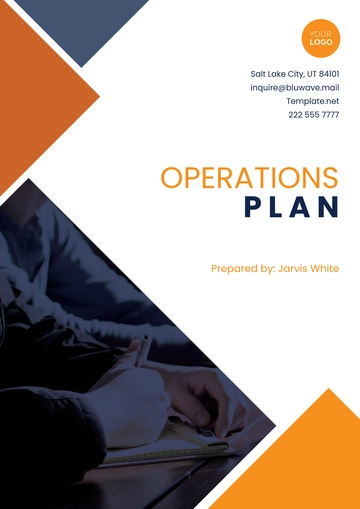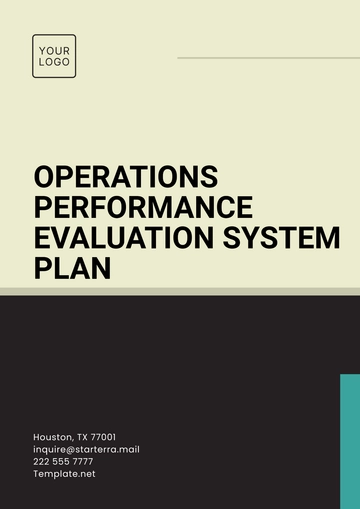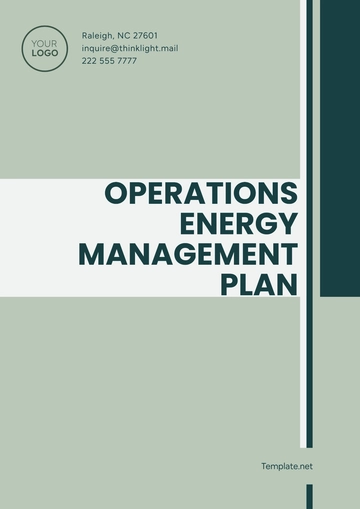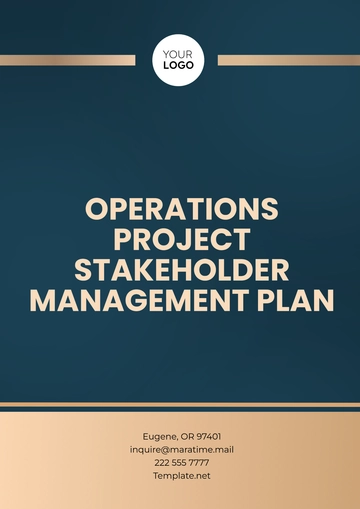Free Operational Improvement Plan

Prepared by | [Your Name] |
Date | [DATE] |
I. Executive Summary
The Operational Improvement Plan aims to enhance efficiency and productivity through the implementation of lean principles. By systematically identifying and eliminating waste, optimizing processes, and fostering a culture of continuous improvement, we intend to achieve significant improvements in throughput while maintaining product quality. This plan outlines the key objectives, strategies, actions required, monitoring and evaluation mechanisms, and performance metrics to embed lean manufacturing practices across our organization successfully.
II. Introduction
This section provides an overview of the current state of manufacturing operations, highlighting the need for improvement to remain competitive in the market. It outlines the purpose and scope of the Operational Improvement Plan and establishes the importance of adopting lean principles to drive operational excellence.
III. Current State Analysis
Process Mapping: Identify and document current production processes at [Your Company Name], highlighting areas of waste and inefficiency.
Waste Identification: Conduct a waste audit to categorize and quantify different types of waste present in the production processes.
Performance Metrics Analysis: Analyze key performance indicators (KPIs) related to productivity, quality, and efficiency to understand current performance levels.
IV. Objectives
Reduce waste across all stages of the manufacturing process.
Improve throughput by streamlining operations and eliminating bottlenecks.
Enhance product quality and customer satisfaction.
Foster a culture of continuous improvement among employees.
Achieve cost savings through optimized resource utilization.
V. Key Strategies
Value Stream Mapping: Conduct a comprehensive analysis of the entire production process at [Your Company Name] to identify value-adding activities and areas of waste.
Just-in-Time (JIT) Production: Implement JIT principles to minimize inventory levels, reduce lead times, and improve responsiveness to customer demands.
5S Methodology: Establish and maintain a clean, organized, and efficient work environment through the application of Sort, Set in order, Shine, Standardize, and Sustain principles.
Kaizen Events: Facilitate cross-functional teams to identify and implement small, incremental improvements in processes and workflows.
Total Productive Maintenance (TPM): Proactively maintain equipment to prevent breakdowns, minimize downtime, and optimize asset utilization.
Employee Training and Engagement: Provide training on lean principles and encourage employee involvement in problem-solving and process improvement initiatives.
VI. Implementation Plan
A. Phase 1: Initial Assessment and Planning (Month 1-2):
Establish a cross-functional lean manufacturing team conduct training sessions, define objectives, and develop a communication plan.
B. Phase 2: Implementation of Lean Practices (Month 3-6):
Conduct value stream mapping workshops, prioritize improvement projects, implement 5S methodology, initiate Kaizen events, and introduce JIT and TPM practices.
C. Phase 3: Monitoring and Continuous Improvement (Ongoing):
Establish visual management systems, conduct Gemba walks, review progress, encourage employee involvement, and celebrate successes.
VII. Performance Metrics
Performance Metrics Tracking
Metric | Measurement Method | Frequency of Measurement | Responsible Party |
|---|---|---|---|
Overall Equipment Effectiveness | Calculation formula | Weekly | Production Manager |
Lead Time | Time tracking system | Daily | Operations Supervisor |
Inventory Turns | Inventory analysis | Monthly | Inventory Manager |
Defect Rate | Quality inspection | Daily | Quality Control Team |
Employee Engagement | Survey | Quarterly | Human Resources |
VIII. Monitoring and Evaluation
A. Performance Metrics Tracking
Continuously monitor KPIs related to productivity, quality, and efficiency at [Your Company Name], analyze trends, and take corrective actions as necessary.
B. Employee Feedback and Engagement
Solicit feedback from employees, conduct satisfaction surveys, and encourage active participation in improvement activities.
C. Review Meetings and Reports
Hold regular review meetings, prepare progress reports, and use review meetings as forums for sharing best practices and addressing barriers to progress.
IX. Resources Required
Resource | Description |
|---|---|
Dedicated lean manufacturing team | The cross-functional team is responsible for implementing lean principles and driving continuous improvement initiatives. |
Training materials | Materials and resources on lean principles for employee training and development. |
Software tools | Data analysis and performance tracking software for monitoring key metrics and trends. |
Budget allocation | Financial resources are allocated for improvement projects, training, and implementation efforts. |
Cross-functional teams | Teams comprising representatives from different departments collaborate on improvement projects. |
X. Risks and Mitigation Strategies
Risk | Mitigation Strategy |
|---|---|
Resistance to change | Provide comprehensive training, communicate benefits, and involve employees in the decision-making process. |
Lack of management support | Engage leadership early, align improvement goals with organizational objectives, and demonstrate ROI. |
Implementation challenges | Break down projects into manageable tasks, involve subject matter experts, and prioritize quick wins. |
XI. Conclusion
The successful implementation of lean manufacturing principles has the potential to revolutionize operations, driving efficiency, reducing waste, and enhancing our competitive position in the market. By diligently executing the Implementation Plan and rigorously monitoring and evaluating progress, we will achieve our objectives and secure a brighter future for our organization.
- 100% Customizable, free editor
- Access 1 Million+ Templates, photo’s & graphics
- Download or share as a template
- Click and replace photos, graphics, text, backgrounds
- Resize, crop, AI write & more
- Access advanced editor
Discover the game-changer for operational excellence with Template.net's Operational Improvement Plan Template. Crafted to perfection, it's not just editable—it's customizable to suit your unique needs. Seamlessly enhance efficiency, streamline processes, and boost productivity. Dive into the future of optimization with this editable gem, exclusively designed for your success. Editable in our Ai Editor Tool for ultimate convenience.
You may also like
- Finance Plan
- Construction Plan
- Sales Plan
- Development Plan
- Career Plan
- Budget Plan
- HR Plan
- Education Plan
- Transition Plan
- Work Plan
- Training Plan
- Communication Plan
- Operation Plan
- Health And Safety Plan
- Strategy Plan
- Professional Development Plan
- Advertising Plan
- Risk Management Plan
- Restaurant Plan
- School Plan
- Nursing Home Patient Care Plan
- Nursing Care Plan
- Plan Event
- Startup Plan
- Social Media Plan
- Staffing Plan
- Annual Plan
- Content Plan
- Payment Plan
- Implementation Plan
- Hotel Plan
- Workout Plan
- Accounting Plan
- Campaign Plan
- Essay Plan
- 30 60 90 Day Plan
- Research Plan
- Recruitment Plan
- 90 Day Plan
- Quarterly Plan
- Emergency Plan
- 5 Year Plan
- Gym Plan
- Personal Plan
- IT and Software Plan
- Treatment Plan
- Real Estate Plan
- Law Firm Plan
- Healthcare Plan
- Improvement Plan
- Media Plan
- 5 Year Business Plan
- Learning Plan
- Marketing Campaign Plan
- Travel Agency Plan
- Cleaning Services Plan
- Interior Design Plan
- Performance Plan
- PR Plan
- Birth Plan
- Life Plan
- SEO Plan
- Disaster Recovery Plan
- Continuity Plan
- Launch Plan
- Legal Plan
- Behavior Plan
- Performance Improvement Plan
- Salon Plan
- Security Plan
- Security Management Plan
- Employee Development Plan
- Quality Plan
- Service Improvement Plan
- Growth Plan
- Incident Response Plan
- Basketball Plan
- Emergency Action Plan
- Product Launch Plan
- Spa Plan
- Employee Training Plan
- Data Analysis Plan
- Employee Action Plan
- Territory Plan
- Audit Plan
- Classroom Plan
- Activity Plan
- Parenting Plan
- Care Plan
- Project Execution Plan
- Exercise Plan
- Internship Plan
- Software Development Plan
- Continuous Improvement Plan
- Leave Plan
- 90 Day Sales Plan
- Advertising Agency Plan
- Employee Transition Plan
- Smart Action Plan
- Workplace Safety Plan
- Behavior Change Plan
- Contingency Plan
- Continuity of Operations Plan
- Health Plan
- Quality Control Plan
- Self Plan
- Sports Development Plan
- Change Management Plan
- Ecommerce Plan
- Personal Financial Plan
- Process Improvement Plan
- 30-60-90 Day Sales Plan
- Crisis Management Plan
- Engagement Plan
- Execution Plan
- Pandemic Plan
- Quality Assurance Plan
- Service Continuity Plan
- Agile Project Plan
- Fundraising Plan
- Job Transition Plan
- Asset Maintenance Plan
- Maintenance Plan
- Software Test Plan
- Staff Training and Development Plan
- 3 Year Plan
- Brand Activation Plan
- Release Plan
- Resource Plan
- Risk Mitigation Plan
- Teacher Plan
- 30 60 90 Day Plan for New Manager
- Food Safety Plan
- Food Truck Plan
- Hiring Plan
- Quality Management Plan
- Wellness Plan
- Behavior Intervention Plan
- Bonus Plan
- Investment Plan
- Maternity Leave Plan
- Pandemic Response Plan
- Succession Planning
- Coaching Plan
- Configuration Management Plan
- Remote Work Plan
- Self Care Plan
- Teaching Plan
- 100-Day Plan
- HACCP Plan
- Student Plan
- Sustainability Plan
- 30 60 90 Day Plan for Interview
- Access Plan
- Site Specific Safety Plan





























